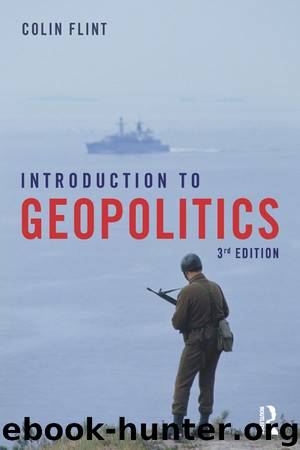Introduction to Geopolitics by Flint Colin

Author:Flint, Colin
Language: eng
Format: epub
ISBN: 9781317275848
Publisher: Taylor and Francis
Published: 2016-10-03T16:00:00+00:00
The geopolitics of making peaceful boundaries
Boundaries are the focus for a variety of geopolitical disputes. Perhaps a geopolitics that concentrates upon the geographic line in the sand, an absolute marker of national identity and state sovereignty, provokes conflict. Boundaries create an absolute world of being either completely within a particular nation-state, or completely outside of it. There is no grey area in this geopolitical vision; the resource is either Hypothetica’s or not, an individual is either a Hypothetican or not. Some argue that a more productive approach is to emphasize the geopolitics of borders rather than boundaries. Reflection upon borders and borderlands may result in trans-boundary interactions that allow for mutual control and utilization of resources and joint economic activities.
Goodwill between neighbours is fundamental to making a peaceful boundary. Mutual trust and shared goals are the basis for cooperation (Newman, 2005, p. 336). Specifically, the following conditions are necessary to facilitate trans-boundary interaction (Newman, 2005, p. 337):
1.
Territorial questions are settled. There is no dispute over where the boundary has been established and how it has been demarcated.
2.
Trans-boundary interaction within the law is easy. The boundary facilitates flows (tourists and labour migrants, for example) between neighbouring countries rather than preventing them.
3.
The boundary provides a sense of security. Rather than being seen as a source of potential conflict, the boundary is seen as a sign of strength as commuting and joint economic projects enhance well-being and eradicate concerns of potential warfare.
3.
Joint resource exploitation is possible. The basis of the peaceful boundary is mutual economic growth through interaction. For example, shared lakes, rivers, and aquifers may be managed jointly. Other examples are the “peace parks” or “free enterprise zones” that minimize the existence of the boundary by creating tariff-free international trade. The boundary as the enclosure of state-imposed taxation is loosened by these zones.
4.
Local administration is coordinated. Emergency services and transportation logistics are examples of how local governments in neighbouring states can create functional integrated areas that straddle an international boundary.
In introducing trans-boundary cooperation, the focus was upon how two states interact politically for economic purposes. The coordination of local administration facilitates interaction, with the main goal being economic gain: increased trade, commuting to work across a political boundary, or jointly harvesting timber or fishing a lake, for example. The assumption is that the increased economic efficiency will strengthen the legitimacy of the separate states. However, cooperation may provoke other questions and concerns. What about issues of identity, if the role of the boundary in delimiting national identity diminishes, and what impact does this have on the way individuals in the borderland identify themselves?
Download
This site does not store any files on its server. We only index and link to content provided by other sites. Please contact the content providers to delete copyright contents if any and email us, we'll remove relevant links or contents immediately.
| Historic | Information Systems |
| Regional |
Man-made Catastrophes and Risk Information Concealment by Dmitry Chernov & Didier Sornette(5946)
The Revenge of Geography: What the Map Tells Us About Coming Conflicts and the Battle Against Fate by Kaplan Robert D(4050)
Zero Waste Home by Bea Johnson(3802)
COSMOS by Carl Sagan(3578)
Good by S. Walden(3513)
In a Sunburned Country by Bill Bryson(3501)
The Fate of Rome: Climate, Disease, and the End of an Empire (The Princeton History of the Ancient World) by Kyle Harper(3029)
A Wilder Time by William E. Glassley(2832)
Camino Island by John Grisham(2775)
Organic Mushroom Farming and Mycoremediation by Tradd Cotter(2655)
The Ogre by Doug Scott(2650)
Human Dynamics Research in Smart and Connected Communities by Shih-Lung Shaw & Daniel Sui(2477)
Energy Myths and Realities by Vaclav Smil(2456)
The Traveler's Gift by Andy Andrews(2431)
9781803241661-PYTHON FOR ARCGIS PRO by Unknown(2338)
Inside the Middle East by Avi Melamed(2320)
Birds of New Guinea by Pratt Thane K.; Beehler Bruce M.; Anderton John C(2233)
A History of Warfare by John Keegan(2205)
And the Band Played On by Randy Shilts(2159)
